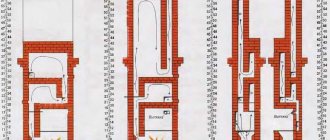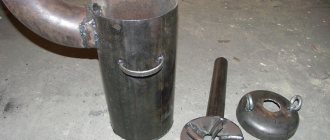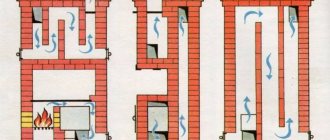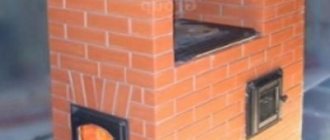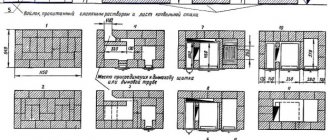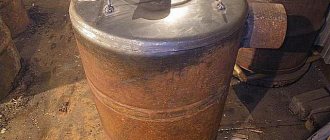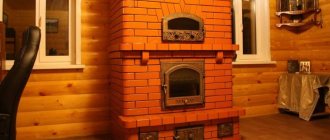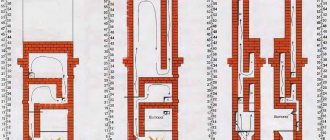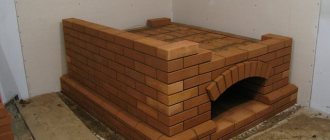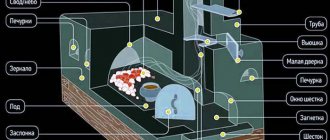Here you will learn:
- Design of a Russian stove with a stove bench
- Advantages and disadvantages of the oven
- Choosing an order
- How to build a Russian stove yourself
- Preparation of clay solution
- Construction techniques
- Do it yourself or order work
- Correct operation
The main distinguishing feature of such a device is the large dimensions of the furnace. In order for an adult to fit on the floors, the length of the entire structure must exceed two meters and the width one and a half meters. The bed itself is located above an elongated furnace, which ensures a constant flow of heat.
Previously, in traditional models, the floors were located under the ceiling, at a height of about 1.8 m, and were climbed onto them using an attached ladder.
This ensured longer preservation of heat - when the hut cooled down in the morning, on the floors, due to the distance from the floor, the temperature was still quite high.
Nowadays, the bed is placed at a comfortable level of about one meter, because modern materials have better thermal insulation of the house.
Reference. In previous years, a high furnace was traditionally built - in addition to heating functions, it was used as a home mini-bath, so it had to accommodate a person, which also influenced the height of the floors.
The scheme, which includes both a hob and a bed, remains the most common. To build such a structure, lightweight schemes have been developed that even a not very experienced builder can handle. The disadvantage of such a stove will be the reduced efficiency of heating the room compared to other models.
Design of a Russian stove with a stove bench
Dimensions of a classic stove: width about one and a half meters (two arshins); length - just over two meters (three arshins); the bed was placed at a height of approximately human height - approximately 180 centimeters (or two and a half arshins), the height of the hearth was approximately 45 cm, the height of the hearth was taken equal to the height of the table.
The stove was erected on a foundation made of small fragments of brick, stones, or less often on a log foundation (oak, pine and other species). The structure was erected at the same time as the house, but their foundations are by no means built together; isolation is a must. The oven itself was built either from baked bricks or from adobe (in those families where income did not allow the use of red brick for construction). The first “dymnitsa” (chimneys) were made of wood, then, due to the fire hazard of the material, wood was replaced with stone and brick.
Furnace design: furnace - firebox, place where fuel combustion occurs; pole and sub-rack - auxiliary table for dishes and a niche under it; under – the bottom of the firebox; hailo - a hole for releasing smoke into the hut; oven - space for storing firewood; mouth - a hole for storing firewood, closed with a flap.
Materials
During the construction process, materials will be required to build a foundation for the device, laying the structure of the furnace and chimney pipe itself, as well as metal cast iron elements in the following quantities:
| No. | Name | Unit measurements | Quantity |
| Furnace design | |||
| 1 | Red burnt solid brick M-200 | Thousand PC. | 1,85 |
| 2 | Fireclay brick ShB – 8 | Thousand PC. | 0,02 |
| 3 | Oily clay | kg | 250 |
| 4 | Coarse river sand | kg | 300 |
| 5 | Blower door | PC. | 1 |
| 6 | Cleaning hatches “DP-1” | PC. | 8 |
| 7 | Grate “RD-6” | PC. | 1 |
| 8 | Fire door 25x28cm “DT-4” | PC. | 1 |
| 9 | Cast iron two-burner stove 70x40 cm | PC. | 1 |
| 10 | Gate valve | PC. | 2 |
| 11 | Strip steel | m | 20 — 25 |
| 12 | Angle steel | m | 1,5 |
| 13 | Steel wire | m | 20 |
| 14 | Sheet steel 5 mm thick | m² | 0,5 |
| 15 | Asbestos cord | m | 15 |
| Foundation | |||
| 1 | Portland cement | T | 0,65 |
| 2 | Construction sand | m³ | 3,5 |
| 3 | Crushed stone | m³ | 4,5 |
| 4 | Ruberoid | m² | 16 |
| 5 | Edged board 40 mm thick | m³ | 0,5 |
| 6 | Nails | kg | 1 |
| 7 | A1 fittings with a diameter of 12 - 14 mm | m | 90 |
| 8 | Steel knitting wire | m | 30 |
| 9 | Bitumen | kg | 10 |
Advantages and disadvantages of the oven
Among the positive qualities of the heating device, the following is noted:
- Cheap design. To build the unit, you will need a minimum of materials: red brick, clay and sand.
- Economical. The efficiency of the simplest device exceeds 60%, and the efficiency of a more complex design is more than 80%.
- Works equally well on various types of solid fuel.
- Functionality (cooking, heating, warm sleeping place).
- The long operating time of the stove allows it to be heated once a day.
- Has therapeutic properties. Food is cooked in it without direct contact with fire and superheated gases. At the same time, the optimal temperature for cooking is maintained. Thanks to these features, carcinogens and toxins are not formed in food. As for relaxing on a bed, six hours of sleep is enough to feel alert and alert in the morning.
- Safety of use. The flame burns deep in the furnace. Sparks can only appear in severe frost.
- Durability. Service life exceeds 30 years.
- The interior of the room with the Russian stove is original, unlike any other.
Disadvantages of a heating unit include the following:
- Possibility of using only solid fuel, which burns slowly. Something that burns quickly requires a lot of air, which can lead to a fire hazard.
- The need for fuel procurement.
- Low heat transfer.
- Not suitable for apartment buildings due to poor smoke circulation. If there is only one channel, combustion products will be removed from the furnace that is heated hotter than the others, while other units will begin to smoke.
- It will take a day to completely heat the device when cold weather sets in.
- The slightest flaws made during the construction of the unit can manifest themselves during operation.
- Takes up a lot of space in the house.
- The need to get rid of waste.
- The air below does not warm up. However, today it is possible to create equipment with bottom heating.
Main types
Over a long period of operation, home stoves were repeatedly modernized in relation to the situation and architectural traditions of a particular area. Their descriptions are found in abundance in literary works.
Swedish stove with bench
By design, devices are divided into the following types:
- Russian. It is a large structure, inside of which there are chimney channels through which combustion products exit into the chimney, heating the walls and the bed. According to the method of removing gases, they are hollow inside and with a channel system. In the first case, only the top is heated. In the second, the generated heat is concentrated below, providing a comfortable microclimate in the room.
- Swede. This technology appeared in Russia at the beginning of the 18th century. The structure is compact, presentable, functional and high-performance. The structure has a vertical orientation with a support area of up to one square meter. A complex chimney system ensures heat flow throughout the entire height of the fireplace. Thanks to this, it is possible to place the hob, fireplace, oven and herbs dryer at different levels.
- Cast iron. The construction is simple, reliable and efficient. It is a metal boiler of regular or long burning, lined with fireclay bricks and tiles. It does not require any special skill during installation, but you will have to pay a lot for the metal.
There are free-standing and combined stoves, large, medium and small, simple and complex geometry. The walls of the structure are left as is, whitewashed, plastered, and decorated with decorative tiles.
Choosing an order
A stove with a stove bench is, first of all, a correctly chosen scheme and order. It depends on it how effective, useful and safe such a heating device will be installed in the house.
A large, spacious lounger warms up well and transfers some of the heat into the room
A large open hearth partially performs the heating function and is intended for cooking
It’s interesting to know: such a brick structure, powered by wood, can have either small dimensions, a bench and combustion chamber, or a more complex structure. The second type involves building a stove with your own hands, additionally equipped with an oven and hob.
Stoves with a stove bench and a hob can also be used for comfortable rest, drying berries, mushrooms, clothes, and shoes.
In addition, brick stoves with a stove bench provide more efficient, uniform heating of rooms. The best heating units are those based on combustion chambers equipped with a long-burning function. Also, long-burning fireboxes belong to the category of the most efficient and economical in terms of consumption of firewood and other types of solid fuel.
A small Swede for a summer residence, equipped with a trestle bed
A stove with a stove bench can be constructed with your own hands according to the Swedish principle. For this, appropriate drawings, orders, and videos are selected. This unit is also complemented by a hob and oven.
Swedish brick stoves are complemented by many stove makers with a stove bench. They are installed between two rooms (bedroom and kitchen) and are capable of uniformly heating rooms with a total area of up to 30 square meters.
The unit, assembled with your own hands from brick, operates in summer and winter mode. To operate in summer, it is necessary to open two existing dampers at once. In the winter season, only one opens, due to which the entire oven begins to warm up, and the heated air masses begin to pass through a long chimney system.
It is interesting to know: the base of such a unit is small, its size is 1148x765 millimeters, with the dimensions of the trestle bed being 1785x638 millimeters.
The lining of the Russian stove with a sunbed is made with one of the most expensive materials - tiles
All traditional Russian stoves installed decades ago were additionally plastered
For construction we will need:
- Red brick 900 units;
- fireclay brick 200 units;
- Blower, door for the combustion compartment, fire doors, grate, hob, steel corners (purchased separately or made to order).
How to build a Russian stove yourself
Classic stoves had dimensions of approximately 2000x3000 mm. Modern designs are considered dimensional if they reach a size of 1500x2300 mm. Small structures include structures with a length and width of up to 1800 mm.
There are several types of similar designs. But they all consist of a number of common elements:
- heating stove;
- bed;
- oven;
- hob;
- ash pit.
There may also be a place for utensils and a woodshed. To build a structure, you need to have an ordering diagram. The article discusses in detail the order of masonry. But first you need to take care of the base.
Work process for constructing a furnace
Foundation structure
The total weight of the structure will be several tons. Such a mass requires the creation of a solid foundation. The base area should be approximately 10-15% larger than the stove base.
The depth of the pit for filling is determined at the rate of 50 mm for every 1000 kg of weight. In our case, we will need an impressive pit.
Remember! The minimum distance of brickwork from the wall is 15 cm
Having retreated the required distance from the wall, they dig a hole, the bottom of which is covered with sand and rubble. Bulk materials are thoroughly compacted. The main depth of the pit is reinforced with steel and filled with concrete. The top of the foundation should be several centimeters below the floor level.
The foundation is allowed to stand for about a month. Cement-sand mixtures crystallize within 4 weeks. The minimum curing period for concrete is 2 weeks. But it’s better not to rush things.
After the composition has completely set, the base is waterproofed. This builds protection against possible penetration of groundwater into the thickness of the furnace. Now you can start laying.
The procedure for laying a stove with a comfortable bench
To build a stove structure, heat-resistant fireclay and/or red bricks, clay and metal fittings (doors, valves) are used.
Order of the stove masonry
When laying a stove with a comfortable bench, you must follow the order. It will not be easy for a non-specialist to understand the jungle of the diagram, so each row is illustrated separately.
Recommendation! If you do not have a professional background as a stove-maker or bricklayer, use the level more often. Achieve strict horizontal and vertical masonry.
- Lay out the first row. This is the most critical stage, on which the quality of the rest of the masonry depends.
- It works the same way.
- The blower door is mounted on this row. It must be taken into account that when heated, metal fittings will increase in volume. Therefore, it is necessary to install the door, avoiding touching it end to end. Typically, strips of asbestos are placed between the stove dampers and the masonry to compensate for expansion.
- Here the schematic laying continues in the same vein as in the previous row. The brick turns out to be “flush” with the fittings.
- Here they start laying the firebox. For this reason, the chamber is reinforced with a lining - it can be seen in the illustration by its different shade. The channel arrangement starts. Install 3 doors for cleaning chambers. The blower damper is completely covered with brick.
- The row duplicates the previous one. The fittings are completely covered with fire-resistant ceramics. The grate is also placed here. Be sure to monitor the brick dressing.
- Arrange caps (vertical channels). The firebox is reinforced with heat-resistant material. Install the firebox door.
- The installation of caps and linings continues. Lifting and lowering “passages” are formed.
- The row duplicates the previous one.
- The row duplicates the previous ones. The caps are already almost 100% laid out here. The lining layer is still being formed.
- The firebox damper is completely covered with masonry. 4 suction channels are installed. The first is carried out from the firebox - into the lifting one, a pair - between the caps. Since the formation of the boundary between the firebox chamber and the chimney (hail) begins here, the fourth channel is made from it - into the side hood.
- In general, the 11th row is being duplicated. The caps are already completely done. Other elements in the process of formation. The lining at this stage tapers into a dome-shaped structure.
- Fireproof reinforcement of the firebox is completed. The firebox and caps are also completed.
- The formation of the overlap continues. At this stage, it is especially important to control the vertical and horizontal, while not forgetting to correctly tie the masonry.
- The formation of the channel continues, which is clearly visible in the illustration. One of the features of this wood-burning structure is the presence of an original side designed for filling with sand. This is not necessary, but warm sand increases the healing properties of the bed. Installing the side does not require much effort, so it is recommended not to abandon it - it will most likely come in handy during the operation of the stove.
- From this to the twentieth rows form a smoke exhaust channel and a protective wall. Despite the lightness of the “extension”, you should carefully monitor the quality of the dressing.
- The next step is to install the stove damper on the smoke exhaust duct.
- This row ends the laying of the protective wall. The chimney damper is completely closed.
- The chimney is laid out from this row to the end. After this, the stove is ready. Despite the intricacy of the design, such a stove with a stove bench can be made with your own hands even by a person far from the stove business.
Recommendation! However, despite the step-by-step instructions, it is better to consult a professional. An experienced stove maker will be able to take into account the individual characteristics of the house and advise on the optimal layout of the structure.
Another ordering option
We will not dwell on this option in detail. From the previous diagram it is easy to understand what each element in the illustration represents.
Figure 5. Layout diagram of another furnace option
This model is one of the simplest. However, it is effective and efficient. Unlike more complex structures, the execution of this one can also be entrusted to even a relatively unprepared homeowner.
Figure 6. Alternative design with a bed
Damper design
The design of the damper is shown in the figure below, where 1 is a sheet of roofing steel, 2 is a handle made of strip steel, 3 is legs made of strip steel to stabilize the damper, 4 is a frame made of angle steel 25x25x3 mm.
It is recommended to make a frame from strip or angle steel and insert it into the masonry of the mouth and then fasten it. In this case, it will serve as formwork when making the arch.
1 – roofing steel sheet; 2 – handle made of strip steel; 3 – legs made of strip steel for stability of the damper; 4 – frame made of angle steel.
Return of traditions
It cannot be said that the Russian stove in the house is a museum exhibit that has unexpectedly returned from the past. In fact, it never disappeared; moreover, it is part of some Russian outbacks that are unfamiliar with main gas.
The massive return of the Russian wet nurse to homes spoiled by civilization is not a tribute to fashion. Most likely, what plays a role here is the desire of people to feel comfortable and cozy in the house, to fill it with the pleasant aroma of baking and to meet with the family in front of an open fire for a delicious dinner cooked in a real Russian oven. After all, not a single miracle of technology will give the sensations and emotions that people experience when they see a flame.
Will help you feel comfortable and cozy in your home
A Russian stove, finished with high-quality materials, does not look like an alien in the house. Today it has become more compact, practical and wear-resistant. A wood-burning stove, depending on its design features, is placed not only in the kitchen, but also in the living room and dining room. For the convenience of housewives, craftsmen integrate everything they need into them, right down to hoods.
A Russian stove without built-in hobs can easily take a central place in a library or bedroom. A lounger can easily replace even the most comfortable chair or even a sofa.
To choose the most suitable project for your home, you need to consider several options in detail. They differ in size, functionality, and of course cost.
Installing a Russian stove in a country house is a job only for professionals. Regardless of construction skills, the construction of such a structure requires not only skills, but also knowledge of its features and technologies.
Interesting design solution
"Alya-Rus" - a designer hit
This model has quite compact dimensions. It does not have additional equipment, such as a hob, a large sun lounger or the ability to observe the flame effect. This option is suitable for a small kitchen. Such a stove is decorated with decorative elements that are associated with Russia. It looks light and charming in a wooden house. Peculiarities:
- Despite the primary simplicity of the decor, such a stove should not be overloaded with accessories. A few decorations will be enough;
- it can be installed not only under the wall. Due to its compactness, it will look good in the center of the kitchen, if space allows.
This option is budget friendly. And if you want a Russian stove in your home, but your budget does not allow for luxury, you can choose this option.
Suitable for rustic style homes
Russian hut - classic style
This design is better suited for rustic-style houses. These can be buildings made of logs, wood, or have a corresponding interior. The classic style is a stove made of brick, decorated with decorative elements.
An excellent option would be to use tiles. They are able to decorate the stove and give it a truly Russian flavor. Such stoves are functional - there is a hob, a large and comfortable sunbed. You can install it in such a way that the functional part is in the kitchen, and the decorative firebox is in the living room. This will give you the opportunity to enjoy the effect of an open flame and the slight crackling of firewood.
Terem - wealth and luxury
A large Russian stove, reminiscent of illustrations from old Russian fairy tales. A design made in this style is a bright accent in any room. It will look beautiful both in a classic and modern interior.
Country style
Characteristics:
- Decoration with a huge number of tiles is allowed. They will only add fabulousness to the design;
- the design is quite large, so it is only suitable for large rooms;
- Many other decorative decorations can be used; they will not overload the structure.
This model can be equipped with a hob, a large lounger, which can be decorated with light fabrics. Often designers suggest installing it near the wall and moving the combustion part into the next room. This will make it possible to simultaneously get a multifunctional Russian stove in the kitchen and a beautiful fireplace in the living room.
Preparation of clay solution
To build and paint a Russian stove at your dacha with your own hands, you will need 3.5 m3 of mortar. To do this, take a certain amount of components and dilute them with water.
You can use an iron barrel as a container. Soak the clay in water and leave it for a couple of days. Next, add sand, and thoroughly mix the entire solution with your feet (after putting on rubber boots) until the mixture is homogeneous. Since the width of masonry joints is no more than 3 mm for fireclay bricks, all large pebbles must be removed from the mortar.
Construction techniques
Opeche
The wooden guard supports a stove weighing up to 1600 pounds (approximately 750 kg), i.e. small or medium without baking. It is made in the form of a log house with two belts, backfilled with rubble and a flooring made of beams. The flooring is covered with felt, properly soaked in a liquid solution of fatty clay, and roofing iron is applied over it.
Wooden stoves are a fire hazard and are now prohibited. Now Russian stoves are placed on a foundation made of brick or concrete blocks, or simply on a concrete floor. If the stove is on a foundation and it is intended to be lined, the foundation around the perimeter must be additionally extended by half a brick, taking into account the mortar layer.
Arches and vaults
Arches and vaults are laid out from an ODD number of bricks on formwork on wooden templates - circles. First, a life-size cross-sectional drawing of the arch is made, then the castle bricks are hemmed onto the wedge. A do-it-yourselfer need not try to lay out a vault with a direct lock or without a lock; not every experienced mason can do this.
Next, the circles are prepared taking into account the thickness of the formwork boards and the vault is laid on them without a lock. Then you need to thickly lubricate the grooves of the locks with the solution and insert the locks into the groove. The next stage is to gradually hammer the locks into place one by one and in several passes. You can't get by with a mallet; you have to use a log. But you can’t beat like crazy; you need to use the inertia of a heavy log, and not the force of a sharp blow.
The quality of the vault closure is controlled by squeezing out the mortar sausages from the seams: it should be more or less uniform over the entire surface. The thick solution flows slowly, so you need to take breaks between passes. The result is a prestressed structure; Only such a vault will last for many decades.
Material consumption
The classic Russian stove described above, depending on the size, requires approximately the following amount of materials:
- Small - 1500 bricks and 0.8 cubic meters. m of solution.
- Average - 2100 bricks and 1.1 cubic meters. m of solution.
- Large - 2500 bricks and 1.35 cubic meters. m of solution.
Note: “approximately” means that some of the material in inexperienced hands will go into battle. Most likely, the vaults will have to be rebuilt at first.
Possible difficulties
When building it yourself and lacking experience, it’s easy to make some mistakes:
- Use of low-quality materials - cheap bricks often have defects or crack when heated to high temperatures.
- If you do not soak the brick before construction, it will draw moisture from the mortar, which will lead to uneven drying and deterioration of the strength and tightness of the masonry.
- The seams between the bricks are filled unevenly and not tightly enough - this later leads to a violation of the seal.
To avoid these and other mistakes, before starting work, it is better to seek advice from an experienced specialist.
Making the foundation
Any construction of a heavy structure always begins with pouring the foundation. But if the house has already been built, then the foundation will have to be created in an already working building. But under any circumstances, the foundation of the house should not be connected to the stove structure. The depth of the foundation depends on how large the stove you plan to build. The more massive, the deeper.
Making a pillow
Before you start pouring the foundation, it is necessary to carry out preparatory work. First, marking work is carried out. Then a pit of a certain depth is dug. Its bottom is carefully compacted. Sand, slightly moistened with water, is poured into the finished pit. The resulting layer is also well compacted. After compaction, the thickness of the resulting sand cushion should reach 100–200 mm.
Then the sand layer is covered with crushed stone. You should get a 150 mm layer. The created stone substrate is also carefully compacted.
We build formwork
In order to begin pouring the solution, the construction and installation of formwork is carried out. The side walls are made of any wooden slats. The resulting gaps are closed with plastic film, which covers the formwork and is secured with a stapler.
This film perfectly replaces ordinary roofing felt. To prevent it from moving, it is nailed with staples. The formwork structure must be raised above the soil surface and reach the height of the foundation. It is allowed to install formwork along the very edge of the pit.
Do it yourself or order work
Does it make sense to take on such complex work yourself? How much does the work of an experienced and reliable stove-maker cost? If 100% of the cost of materials, as is customary in general construction work, then it is not that expensive.
By no means, not twice as much against the material. You can come across offers to build a stove for 20,000 rubles, but this is obvious nonsense. Let's try to figure it out ourselves.
Russian stove with stove
A stove maker works in mid-latitudes for six months, and always with an apprentice. Considering their employment at 100% of working time, the salary of a master at 25,000 rubles, and an assistant at 15,000, and the work completion time is 7 working days (this is a completely realistic period), we find that a simple stove will cost no less than 45,000 rubles, and a Russian stove with a stove and water heater (see figure) at 55,000-60,000 rubles.
But in a week it will be possible to heat it. There is only one condition: the master must tell where, when and to whom he has already installed the stoves, and they must be inspected personally. Good masters always stock up on recommendations, and if they hesitate and mumble, it’s better to turn to someone else.
Varieties
A do-it-yourself stove can be built with a shield built into the body (structure) of the stove, and then in appearance it is indistinguishable from the stove, pos. 1 in Fig. The rough-slab is compact, the least material-intensive, the lightest, and requires a minimum amount of additional construction work, but its thermal power is limited to 10-12 kW, and then with great effort. Therefore, rough slabs are installed mostly in seasonal dachas (spring-autumn) with occasional trips there in winter, hunting lodges, etc. An important advantage of a rough slab is that it can be built without a foundation directly on the floor, if its load-bearing capacity is at least 500 kgf/sq. m.
Types of rough ovens
A rough structure with an attached shield (item 2) is structurally more complex and heavier, although a simplified foundation (see below) is also suitable for it, but its thermal power is potentially greater. A wood-burning grub with an attached shield can develop up to 16-18 kW; on coal - up to 20-22 kW. The diagram of the flow of flue gases in the hood with a shield is given in pos. 3; This is how the popular Galanka stove was built. However, you need to know that there is no point in building a furnace with more than 3 revolutions: such a furnace with a single cycle will be simpler and cheaper. In addition, during construction it will be necessary to pay special attention to some of the features of rough stoves, the consideration of which is devoted to a significant part of the article.
Note: roughing on wood can also be done with a stove bench, see below. It is not advisable to heat such a stove with coal; the stove will overheat.
Why is it rude - rude
Visually, a rough stove can be distinguished from a stove with a later added shield due to the integrity of the structure (item 4), but in essence they are one and the same. The calculation of a heat-efficient furnace is very complex and requires fairly deep knowledge of heating engineering, and the development of a furnace design based on its results also requires solid practical experience. It is much easier to design and build a rough fire because its furnace (fire) part and the shield are calculated separately, and then “molded” together according to the rules for pairing building structures, taking into account the requirements of heating engineering. Naturally, the thermal efficiency of the resulting device will be lower, because the interaction of the thermal cycles of the fire part and the shield is not taken into account, and it is by taking it into account that it is possible to increase the efficiency of a single cycle furnace. Therefore, if you live in an area with a harsh climate, a rude stove may only make sense for you as a seasonal stove for temporary use.
Correct operation
To use the device correctly and safely, the following rules must be observed:
- Carefully monitor the condition of the chimney and clean it from ash in a timely manner.
- Before each kindling, check the quality of the draft - this will help prevent smoke from entering the room.
- If the stove has not been used for a long time, a thorough inspection is carried out for damage and cracks.
- You should not light a stove while intoxicated or very tired; it is not recommended to leave small children alone near a burning stove.
Precise construction and compliance with all operating rules will ensure high-quality operation of the stove, efficient heating of the house, and the preparation of delicious traditional dishes.
